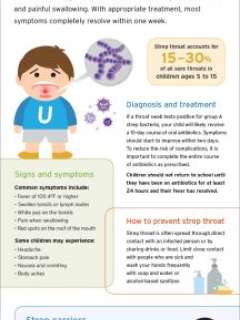
Up to 30% of sore throats among children between the ages of 5 and 15 are due to group A Streptococcus (strep), a contagious bacterial infection that causes fever, sudden onset of a sore throat, swollen tonsils and painful swallowing. With appropriate treatment, however, most symptoms completely resolve within one week.
Diagnosis and treatment
If your child exhibits symptoms common with a strep infection — such as a sore throat, fever, swollen neck glands or pus on the tonsils — schedule a visit with your child’s pediatrician.
To diagnose strep throat, your doctor will collect a throat swab to test for group A strep bacteria. “If your child tests positive, he or she will likely receive a 10-day course of oral antibiotics (duration can vary),” says , UCLA infectious disease specialist. “While symptoms should improve within a couple of days of starting antibiotics, it is important to complete the entire course of antibiotics as prescribed.” This helps prevent spreading the disease to others and reduces the risk of rare complications such as rheumatic fever. Children should not return to school until they have been on antibiotics for at least 24 hours and their fever has resolved.
How to prevent strep throat
“Strep throat is often spread through direct contact with a person who is ill,” Dr. Adachi says. “Sometimes, children may also contract strep throat by sharing personal items (toys, food or drinks) with a strep infected person.” To avoid infection, children should limit close contact with people who are sick and wash their hands frequently with soap and water or alcohol-based sanitizer.

Signs and symptoms
Common symptoms include:
- Fever of 100.4°F or higher
- Swollen tonsils or lymph nodes
- White pus on the tonsils
- Pain when swallowing
- Red spots on the roof of the mouth
Some children may also experience:
- Headache
- Stomach pain
- Nausea and vomiting
- Body aches
Strep carriers
It is believed that up to 25% of healthy children may be chronic carriers of group A strep, meaning they test positive for strep bacteria even when they show no symptoms of infection. Strep carriers are less likely to be contagious and have a lower risk of strep-related complications. Most children diagnosed with chronic strep will not require treatment.



